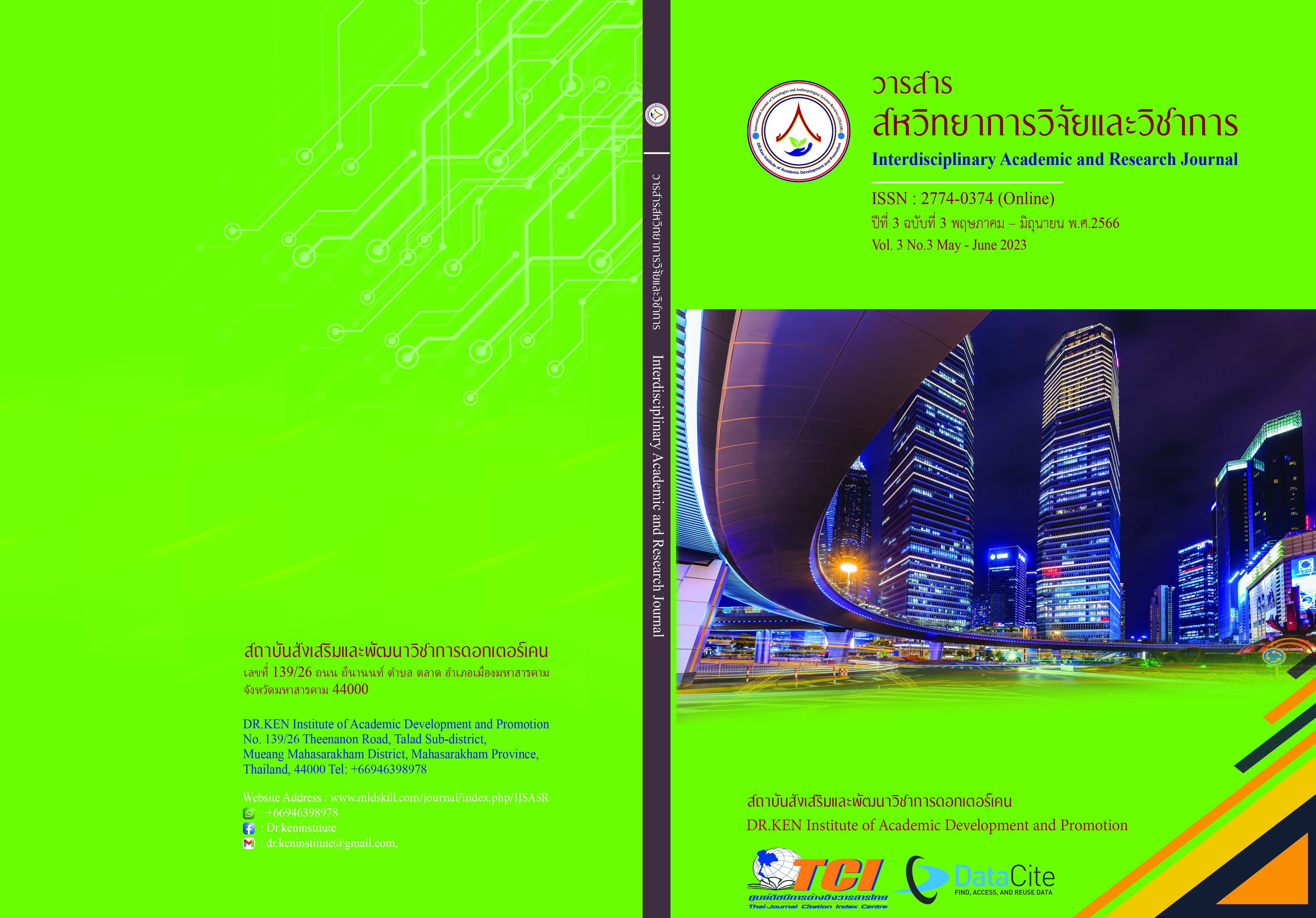Community Economic Development under the Impact of the COVID-19 Outbreak for Sustainable Development in Kaeng Loeng Chan Subdistrict
DOI:
https://doi.org/10.14456/iarj.2023.163Keywords:
Community Economy; , Sufficiency Economy Philosophy; , Model Sufficiency Economy VillageAbstract
The trend of economic development that has developed along with building immunity for the people by adopting the philosophy of sufficiency economy as a model to drive the country in the 12th National Economic and Social Development Plan of Thailand, which is important not only applicable to the agricultural sector but also applies to the development of the country's economy and society to be stronger and more sustainable, however, "sufficiency economy", It is a concept of His Majesty the King, a concept based on the foundation of Thai culture. Therefore, this research aims to; (1) Study the economic, social, environmental, potential, and local wisdom of the community. (2) Create a model for community economic development based on natural resources and local wisdom following the sufficiency economy approach. (3) Apply the community economic development model to be applied in the area and assess the results of sustainable community economic development by using the community participation process. This study was conducted in Kaeng Loengchan Sub-district, Mueang District, Maha Sarakham Province. The sample used in the research were people who were willing to participate in the research, who were the pilot households of Kaeng Loengchan sub-district communities, Muang district, Maha Sarakham province. Leaders of community enterprise groups and community enterprise members growing organic vegetables Khao Lam rice production community enterprise group, 80 people. Data collection tools include participatory action research processes, brainstorming sessions, and interviews. Use qualitative data analysis techniques. The study found that; (1) The problem conditions and needs of the group are packaging is not up to standard, public relations and distribution channels are scarce, as for the organic vegetables group, there is still a lack of public relations, lack of promotion of distribution channels. (2) The model for developing a community economy based on natural resources and local wisdom according to the sufficiency economy approach consists of 3 main activities which are; (2.1) The development of organic vegetable growing groups to be safe vegetable markets, watershed development, workshops on soil maintenance, insect repellent production, water systems, organic planting systems, and official development. Marketing such as distribution channels, public relations, developing a safe vegetable market, public relations through online media, labeling the entrance to the market, making access to the vegetable market more convenient for customers, creating a logo for the organic vegetable group, and developing packaging to be modern. (2.2) Development of the Khao Lam Sam Rom group by creating a prominent public relations sign and developing the group's packaging and logo. Increase distribution channels. (2.3) The establishment of a fish farming group in Krabang because the group members want to develop agro-tourism tourism and therefore want to have a variety of agricultural products that can meet the needs of consumers, therefore establishing a fish farming group near the organic vegetable planting group to have more income, and can be consumed in the household to reduce expenses. And (3) Evaluation of the efficiency of community economic development according to the philosophy of sufficiency economy by using the prototype sufficiency economy village assessment form. It was found that 20 indicators were evaluated out of a total of 23 indicators, at the level of “Good eating- good living”, there are 3 additional indicators that the community needs to develop, namely indicators 4, 6, and 22.
References
ชิดชนก ปรีชานันท์ (2560). การวิจัยเชิงปฏิบัติการแบบมีส่วนร่วมในการพัฒนาวิทยากร กระบวนการเพื่อขับเคลื่อนสู่ชุมชนเศรษฐกิจพอเพียง สำหรับเจ้าหน้าที่เทศบาลตำบลรังกาใหญ่ อำเภอพิมาย จังหวัดนครราชสีมา. วารสารราชพฤกษ์, 15 (3), 97-104.
พระมหาประกาศิต สิริเมโธ (ฐิติปสิทธิกร. (2556). การมีส่วนร่วมของประชาชนในหมู่บ้านเศรษฐกิจพอเพียงของชุมชนบ้านคลองใหม่ อำเภอสามพราน จังหวัดนครปฐม. วิทยานิพนธ์ปรัชญาดุษฎีบัณฑิต: มหาวิทยาลัยมหาจุฬาลงกรณ์ราชวิทยาลัย.
พิริยะ ผลพิรุฬห์. (2556). เศรษฐกิจสร้างสรรค์กับการพัฒนาประเทศไทย. วารสารเศรษฐศาสตร์ปริทรรศน์ สถาบันพัฒนศาสตร์. 7 (1), 1-69.
รัถยานภิศ พละศึก, เบญจวรรณ ถนอมชยธวัช และ ดลปภัฎ ทรงเลิศ. (2561).การวิจัยเชิงปฏิบัติการแบบมีส่วนร่วม: กระบวนการพัฒนาการสร้างเสริมสุขภาพชุมชนอย่างมีส่วนร่วม. วารสารเครือข่ายวิทยาลัยพยาบาลและการสาธารณสุขภาคใต้. 5 (1), 211-223.
รัถยานภิศ พละศึก, เบญจวรรณ ถนอมชยธวัช และ ดลปภัฎ ทรงเลิศ. (2561).การวิจัยเชิงปฏิบัติการแบบมีส่วนร่วม: กระบวนการพัฒนาการสร้างเสริมสุขภาพชุมชนอย่างมีส่วนร่วม. วารสารเครือข่ายวิทยาลัยพยาบาลและการสาธารณสุขภาคใต้. 5 (1), 211-223.
วันรักษ์ มิ่งมณีนาคิน. (2531). การพัฒนาชนบทไทย. กรุงเทพมหานคร : โรงพิมพ์มหาวิทยาลัยธรรมศาสตร์.
สำนักงานคณะกรรมการพัฒนาเศรษฐกิจและสังคมแห่งชาติ. (2559). สรุปสาระสำคัญแผนพัฒนาเศรษฐกิจและสังคมแห่งชาติ ฉบับที่สิบสอง พ.ศ. 2560-2564. กรุงเทพฯ: สำนักงานคณะกรรมการพัฒนาเศรษฐกิจและสังคมแห่งชาติสำนักนายกรัฐมนตรี
สำนักงานพัฒนาเศรษฐกิจและสังคมแห่งชาติ. 2559). สรุปสาระสำคัญแผนพัฒนา เศรษฐกิจและสังคมแห่งชาติ ฉบับที่สิบสอง พ.ศ. 2560-2564. กรุงเทพฯ: สำนักงาน คณะกรรมการพัฒนาเศรษฐกิจและสังคมแห่งชาติสา นกันายกรัฐมนตรี
สุพิมล ขอผล และคณะ (2557). การใช้การวิจัยเชิงปฏิบัติการแบบมีส่วนร่วมในการป้องกัน และแก้ไขปัญหาการดื่มสุราในชุมชนหมู่บ้านหนองเต่าคําใหม่ ตำบลป่าไผ่ อำเภอสันทราย จังหวัดเชียงใหม่. วารสารการพัฒนาชุมชนและคุณภาพชีวิต. 2 (3), 313-324.
อติญาณ์ ศรเกษตริน, รุ่งนภา จันทรา และ ชุลีพร หีตอักษร (2561). การวิจัยเชิงปฏิบัติการแบบมีส่วนร่วมของผู้ใช้บริการ ในการพัฒนาตลาดสดสุขภาพ. วารสารราชภัฏสุราษฎร์ธานี. 5 (2), 197-212.
อติญาณ์ ศรเกษตริน, รุ่งนภา จันทรา และ ชุลีพร หีตอักษร (2561). การวิจัยเชิงปฏิบัติการแบบมีส่วนร่วมของผู้ใช้บริการ ในการพัฒนาตลาดสดสุขภาพ. วารสารราชภัฏสุราษฎร์ธานี. 5 (2), 197-212.
อุ่นเรือน เล็กน้อย (2561). แนวทางการสร้างกระบวนการพันธกิจสัมพันธ์กับชุมชนเพื่อขับเคลื่อนกรุงเทพมหานคร. วารสารการจัดการสิ่งแวดล้อม.14 (2), 79-95.
Downloads
Published
How to Cite
Issue
Section
License
Copyright (c) 2023 Thanyachanok Pawala, Narawich Sripauya, Suphot Ketdow, Janthappapha Thanapraditkoon

This work is licensed under a Creative Commons Attribution-NonCommercial-NoDerivatives 4.0 International License.
Copyright on any article in the Interdisciplinary Academic and Research Journal is retained by the author(s) under the under the Creative Commons Attribution-NonCommercial-NoDerivatives 4.0 International License. Permission to use text, content, images, etc. of publication. Any user to read, download, copy, distribute, print, search, or link to the full texts of articles, crawl them for indexing, pass them as data to software, or use them for any other lawful purpose. But do not use it for commercial use or with the intent to benefit any business.
















.png)


